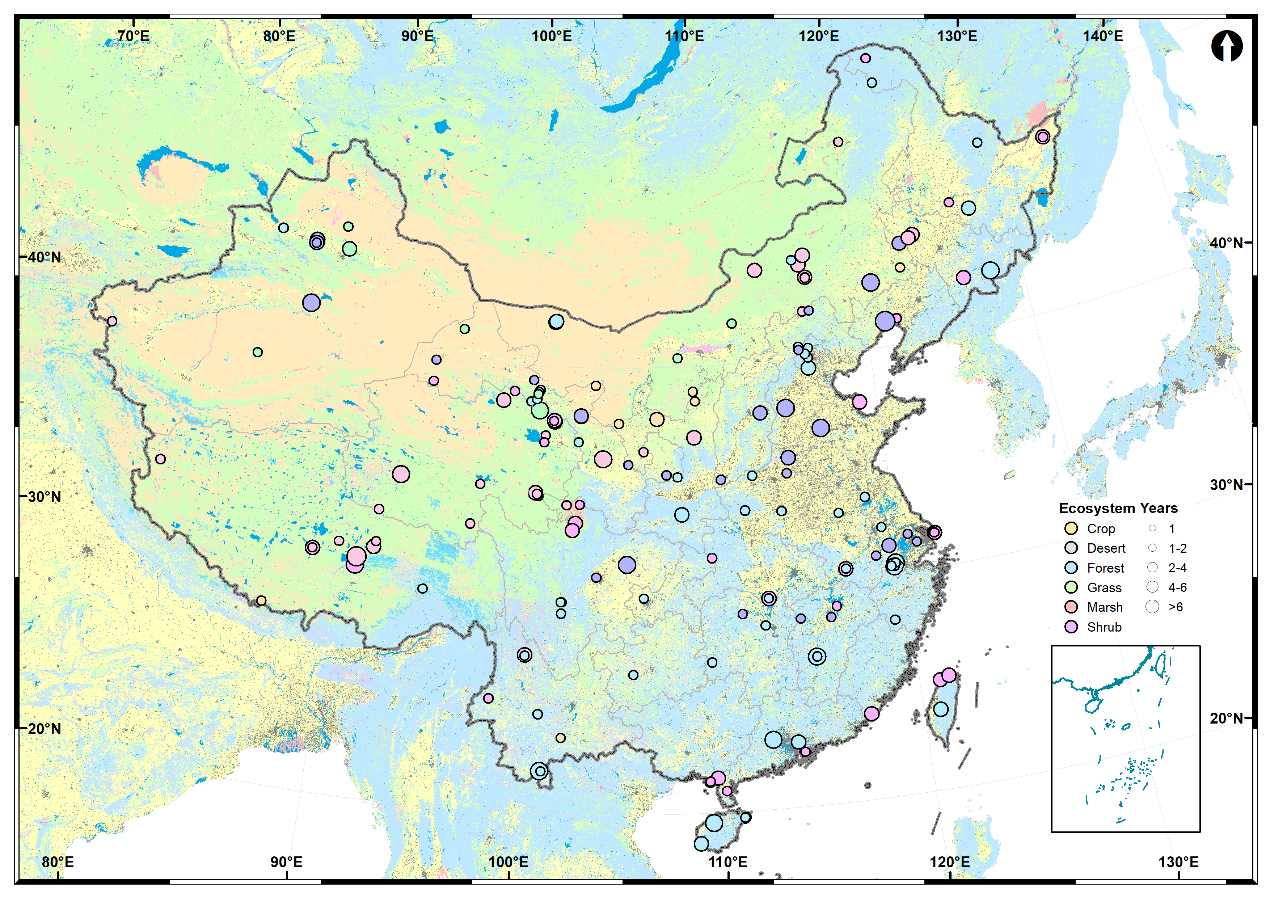Data Description:
A total of 204 eddy covariance (EC) observation sites covering all ecosystem types and climate zones in China were identified. Data were obtained for a total of 526 site years, i.e., 2.5 years per site. Limited by the data-sharing culture in China, most data were obtained from peer-reviewed papers, i.e. the Web of Science, for English-language papers (http://apps.webofknowledge.com/), and the China National Knowledge Infrastructure, for Chinese papers (https://www.cnki.net/). The following keywords were used during the literature search: eddy covariance, CO2 flux\exchange\sink\source, and China. Several criteria were used to guarantee the data quality of the studies in the literature review. First, the data collection must have used the EC technique to ensure the spatial and temporal coverage. Static-chamber-based observations, especially manual static chambers, were excluded due to their relatively small spatial coverage (typically less than 1 m2) and low temporal coverage (usually conducted in the daytime at weekly intervals). Second, observations had to cover at least a whole year, given non-growing-season CO2 emissions play a significant role in affecting the annual-scale CO2 sink. Third, the paper had to include a clear description of the EC installation, data collection and processing procedures (Webb–Pearman–Leuning correction, axis rotation, etc.). All sites were subjected to Webb–Pearman–Leuning density correction, and most sites were determined by the coordinate axis rotation approach, i.e., 2D, 3D or planar fit coordinate axis rotation. And finally, the observation data had to be clearly and correctly presented, and papers with incorrect units of measurement were not included.
Observation location:
The dataset covered all the major ecosystem types of China: forest (61 sites), grassland (43 sites), wetland (38 sites), cropland (41 sites), desert (12 sites), and shrubland (10 sites), i.e., 204 sites in total. All studies that met the above standards were then processed with GetData Graph Digitizer 2.2.6 (www.getdata-graph-digitizer.com). From the perspective of climate coverage, the EC sites are well distributed over China’s climate gradient, albeit with relatively fewer sites in cold–dry and hot–wet areas, which is consistent with less common sites in northwestern China. From the perspective of the study period, most observations were conducted during 2002–2020, with a mean of 2012. More than half of the sites (124) were studied for more than 2 whole years, while only 80 sites were studied for 1 whole year. The dataset presented here is therefore representative of China in terms of its ecosystems, climate and regional contributions, albeit with a slight regional bias.

Fig. 1 Location of eddy covariance observation sites across China’s terrestrial ecosystems. The base map is based on a 30-m resolution land cover map of China. The color of each dot represents the ecosystem type, while the size of each dot represents the number of observation years.
Keywords:
dissolved organic carbon; nitrogen deposition; biodegradability of DOC; montane forest
Funding information :
1. National Natural Science Foundation of China (Grant No.41977398)
2. The Youth Innovation Promotion Association CAS, China (Grant No.2018406)
Data availablity:
The dataset will be open access after the acceptance of submitted article. Before that, dataset are available on request from the corresponding author (Prof. Da Wei).
Contact information:
Da Wei (weida@imde.ac.cn)
Institute of Mountain Hazards and Environment, Chinese Academy of Sciences
4-9, Renmin South Road, Chengdu, China.
 This work is licensed under a Creative Commons Attribution 4.0 International License.
This work is licensed under a Creative Commons Attribution 4.0 International License.
Recommended citation:
Da Wei. 2022. Eddy Covariance Dataset for China’s Terrestrial Ecosystems. Mountain Science Data Center,
Acknowledge:
The dataset is provided by Mountain Science Data Center, Institute of Mountain Hazards and Environment, Chinese Academy of Sciences
